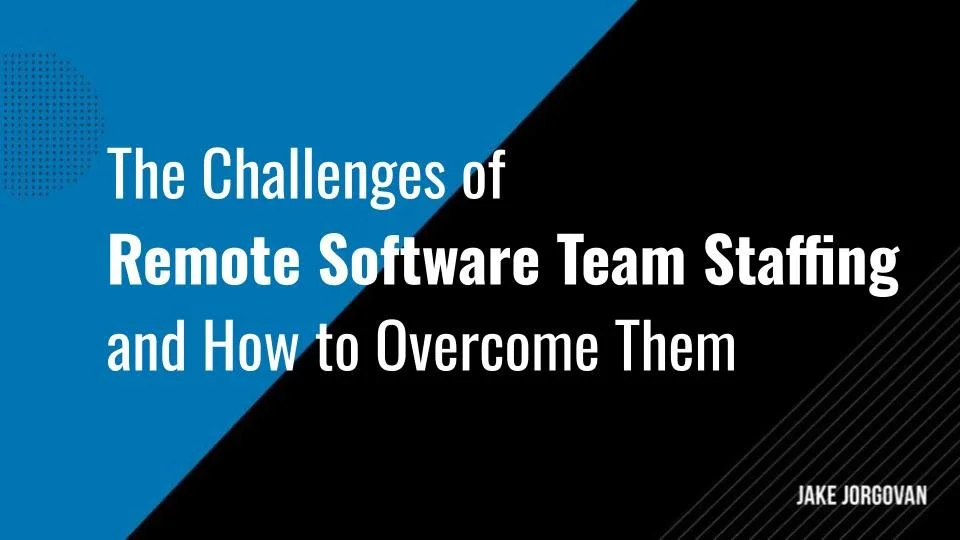Engaging and Retaining Software Talent in a Highly Competitive Market
In today's cutthroat tech industry, attracting skilled software developers is just half the battle. The real challenge is retaining them.
Here are the seven strategies we’ll discuss in this article:
Strategies to foster a collaborative and innovative work environment.
Ways to inspire creativity and effective problem-solving.
The importance of continuous learning and advancement opportunities.
How competitive compensation and benefits play a crucial role.
The impact of connecting daily work with a greater organizational mission.
Leadership's role in mentorship and career development.
Recognizing achievements to motivate and retain top talent.
Insights into turnover causes and how to address them effectively.
Continue reading to learn how to engage and retain your software talent in this highly competitive market.
1. Create a Collaborative Work Environment
Creating a collaborative work environment means ensuring every developer feels their input is valued and considered.
It’s about establishing a culture of open communication where diverse perspectives are sought and respected.
People who feel they matter are likelier to remain part of your team and value your brand.
To achieve this:
Encourage cross-functional teams to collaborate on projects, breaking down silos and fostering innovation.
Implement regular brainstorming sessions where all levels of staff can contribute ideas.
Ensure decision-making processes are transparent and inclusive.
These tactics enhance project outcomes and build a sense of ownership and accountability among team members, leading to a more engaged and committed workforce.
2. Encourage Creativity and Problem-Solving
Encouraging creativity in problem-solving allows developers to approach challenges innovatively, leading to unique and efficient solutions.
Granting this creative freedom boosts their engagement, as they feel trusted and valued for their input.
To foster this environment:
Provide opportunities for developers to experiment with new technologies and methodologies in their projects.
Organize hackathons or innovation labs where they can explore and innovate without the pressure of immediate deliverables.
This approach advances technical skills and strengthens team trust and cohesion, as members appreciate the shared commitment to growth and excellence.
Besides, encouraging creativity and problem-solving in software development has measurable benefits.
Studies show that creative problem-solving sessions can generate 350% more ideas, and those ideas are 415% more original with even minimal training in creativity tools and principles.
Furthermore, solving problems efficiently is integral to software development, as it's estimated that 60% of the costs associated with the software development lifecycle relate to maintenance tasks, including debugging and problem-solving.
These statistics underline the importance of nurturing an environment where developers can leverage their creativity and problem-solving skills.
This leads to more innovative and original solutions and significantly impacts the efficiency and quality of software development.
So, if you encourage such skills, you will hit two birds with one stone:
Maintain the momentum of development projects, ensuring they progress smoothly and effectively
Foster a culture of continuous improvement and innovation.
3. Provide Opportunities for Skill Advancement
Offering opportunities for skill advancement is crucial to keeping software talent motivated and current. Continuous learning is essential in the fast-evolving tech landscape.
Besides, employers who receive this chance to advance feel more motivated and valued. And people don’t tend to boot jobs they like or thrive at.
You can facilitate this by sponsoring certifications, hosting workshops, and providing access to online courses from platforms like Coursera or Udemy. Encourage attendance at industry conferences or webinars, enabling employees to stay ahead of trends and network with peers.
Implementing mentorship programs can also play a significant role, pairing less experienced developers with seasoned professionals to foster knowledge exchange.
Besides, In-house training sessions led by expert employees on emerging technologies or methodologies can further enhance the team's capabilities.
As you can see, all these initiatives signal an investment in employees' professional growth, leading to increased job satisfaction and retention.
4. Offer Competitive Salary and Compensation Packages
Creating competitive salary and compensation packages for software developers involves recognizing and valuing their contributions.
First, conduct market research to understand the current industry standards for similar roles and experience levels.
Use salary surveys and industry reports to gauge the going rates for tech talent. Beyond base pay, consider comprehensive benefits like health insurance, retirement plans, stock options, and bonuses tied to performance or project milestones.
Flexible working conditions, such as remote work options and flexible hours, can also be part of a compelling compensation package.
Next, tailor these packages to meet the expectations and needs of your talent, showing that you value their well-being and career growth.
Pro tip: Regularly review and adjust compensation structures to remain competitive, retain top talent, and attract skilled professionals in a dynamic market.
In 2024, competitive salary structures for software engineers vary widely based on location and role.
In the United States, the average software engineer earns around $139,702 annually, with salaries in tech hubs like San Francisco reaching up to $171,000.
Senior positions, like lead software engineers, can command salaries of $218,000, while principal engineers can earn up to $264,000.
Globally, the salary range differs, with software engineers in countries like Germany earning around €65,000 (USD 75,000) and those in India around ₹900,000 (USD 10,366).
The competitive nature of these salaries highlights the importance of companies offering fair compensation to attract and retain top talent.
That’s why you should stay informed about the current market rates. By ensuring that compensation packages are in line with or exceed industry standards, you acknowledge the value of developers' work and maintain a competitive edge in the tech industry.
5. Connecting Work to a Greater Purpose
Connecting work to a greater purpose means helping employees see the broader impact of their contributions.
To achieve this:
Communicate how their technical efforts align with the company's mission and societal benefits.
Show them the real-world applications of their projects, like improving healthcare, advancing education, or enhancing environmental sustainability.
Encourage participation in initiatives that reflect the organization's values, such as community service or green programs.
Regularly share success stories and customer feedback to demonstrate the tangible outcomes of their work.
All these tactics foster a sense of purpose and strengthen organizational commitment. As your employees understand their role in the bigger picture, they will feel proud of their contributions to meaningful goals.
6. Fostering Leadership and Mentorship
Leadership and mentorship are key to developing a resilient team capable of tackling complex challenges and driving innovation.
Fostering leadership and mentorship within a software development team involves leveraging the experience of seasoned leaders to guide less experienced developers.
One way to do this is to implement mentorship programs that pair junior staff with senior members for one-on-one coaching, focusing on technical skills, career guidance, and personal development.
This tactic facilitates knowledge transfer, accelerates learning, and enhances problem-solving abilities.
Experienced leaders should also cultivate a supportive team culture, encouraging open communication, collaboration, and continuous feedback.
This approach leads to skill development, strengthens team bonds, creates a more cohesive work environment, and promotes a culture of continuous improvement and shared success.
7. Recognition, Achievement, and Career Pathways
Ensuring recognition, achievement, and clear career pathways is crucial for software talent retention and satisfaction.
This mindful approach instills a sense of growth and fulfillment, motivating software professionals to continue contributing their best work.
The best methods to achieve this include to:
Regularly acknowledge and celebrate individual and team successes, big and small, to validate their efforts and contributions.
Implement a transparent career progression framework that outlines the skills, experiences, and achievements needed to advance to the next level. This structure provides employees with clear goals and a roadmap for their professional development.
Encourage employees to set personal career objectives and support these with tailored development plans, including training, workshops, and stretch assignments.
Understanding Turnover Causes
We took you through seven methods of engaging and retaining software talent,
They all have proven great success, but they can feel generic.
To develop effective talent retention strategies that fit your business, you must understand your company’s turnover causes.
Pro tip: Conducting exit interviews is a key method for gaining insights into why employees decide to leave.
These interviews should be structured to encourage honest and constructive feedback, covering aspects like job satisfaction, management style, career development opportunities, and workplace culture.
Analyzing this data can reveal patterns and pinpoint areas for improvement. Use the findings to address common grievances and enhance the work environment.
For instance, if career progression emerges as a recurring issue, focus on enhancing career pathways and development programs.
Remember: Proactively addressing the causes of turnover can lead to higher retention rates, as it shows a commitment to continuous improvement and employee well-being.
Conclusion
Engaging and retaining software talent offers significant advantages in a competitive market. It ensures your team stays strong and skilled and keeps your company innovative and ahead of the curve.
And you learned the best tools for that.
Fostering a collaborative work environment, encouraging creativity and problem-solving, offering skill advancement opportunities, providing competitive compensation, and connecting work to a greater purpose are key to engaging and retaining software talent.
Leadership and mentorship, recognizing achievements, and understanding turnover further support these efforts.
Follow the advice in this article, and you’ll build a workplace where software professionals feel valued, motivated, and connected to their work and your organization's broader mission.


























